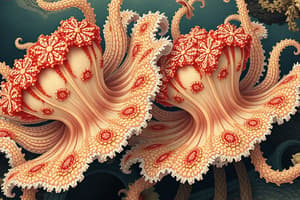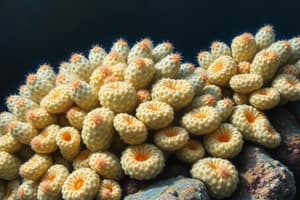Podcast
Questions and Answers
What is the level of organisation in sponges?
What is the level of organisation in sponges?
- Cellular level (correct)
- Organ level
- Tissue level
- Organ system level
What is the function of the water transport system in sponges?
What is the function of the water transport system in sponges?
- Only for reproduction
- For food gathering, respiratory exchange and removal of waste (correct)
- Only for respiratory exchange
- Only for removal of waste
What lines the spongocoel and canals in sponges?
What lines the spongocoel and canals in sponges?
- Choanocytes or collar cells (correct)
- Egg cells
- Muscle cells
- Sperm cells
How do sponges reproduce asexually?
How do sponges reproduce asexually?
What is the function of spicules or spongin fibers in sponges?
What is the function of spicules or spongin fibers in sponges?
What is the type of fertilisation in sponges?
What is the type of fertilisation in sponges?
What is the larval stage in sponges?
What is the larval stage in sponges?
What is the characteristic of sexes in sponges?
What is the characteristic of sexes in sponges?
What is the outer covering of the body of a mollusk?
What is the outer covering of the body of a mollusk?
What is the function of the radula in mollusks?
What is the function of the radula in mollusks?
What is the characteristic of the development of mollusks?
What is the characteristic of the development of mollusks?
What is the name of the space between the visceral hump and the mantle in mollusks?
What is the name of the space between the visceral hump and the mantle in mollusks?
What is the characteristic of the body of an echinoderm?
What is the characteristic of the body of an echinoderm?
What is the level of organisation of echinoderms?
What is the level of organisation of echinoderms?
What is the characteristic of the symmetry of adult echinoderms?
What is the characteristic of the symmetry of adult echinoderms?
What is the location of the anus in echinoderms?
What is the location of the anus in echinoderms?
What is the main characteristic of the endoskeleton of Chondrichthyes?
What is the main characteristic of the endoskeleton of Chondrichthyes?
What is the function of the electric organs in some Chondrichthyes?
What is the function of the electric organs in some Chondrichthyes?
What is unique about the jaws of Chondrichthyes?
What is unique about the jaws of Chondrichthyes?
What is the main reason why Chondrichthyes have to swim constantly?
What is the main reason why Chondrichthyes have to swim constantly?
What is the characteristic of the heart of Chondrichthyes?
What is the characteristic of the heart of Chondrichthyes?
What is the mode of fertilisation in Chondrichthyes?
What is the mode of fertilisation in Chondrichthyes?
What is the characteristic of the skin of Chondrichthyes?
What is the characteristic of the skin of Chondrichthyes?
What is the characteristic of the body temperature regulation in Chondrichthyes?
What is the characteristic of the body temperature regulation in Chondrichthyes?
What type of symmetry do chordates possess?
What type of symmetry do chordates possess?
What is the characteristic of the central nervous system in chordates?
What is the characteristic of the central nervous system in chordates?
What is the characteristic of the pharynx in chordates?
What is the characteristic of the pharynx in chordates?
What is the location of the heart in chordates?
What is the location of the heart in chordates?
What is the characteristic of the post-anal part in chordates?
What is the characteristic of the post-anal part in chordates?
How many subphyla are there in the phylum Chordata?
How many subphyla are there in the phylum Chordata?
What is the characteristic of notochord in Urochordata?
What is the characteristic of notochord in Urochordata?
What is the characteristic of notochord in Cephalochordata?
What is the characteristic of notochord in Cephalochordata?
Which group of organisms is characterized by the presence of a water vascular system?
Which group of organisms is characterized by the presence of a water vascular system?
What is the relationship between vertebrates and chordates?
What is the relationship between vertebrates and chordates?
What is the importance of air bladders in Pisces?
What is the importance of air bladders in Pisces?
Which modifications help birds fly?
Which modifications help birds fly?
Can the number of eggs or young ones produced by an oviparous and viviparous mother be equal?
Can the number of eggs or young ones produced by an oviparous and viviparous mother be equal?
In which group is segmentation first observed?
In which group is segmentation first observed?
Flashcards are hidden until you start studying
Study Notes
Phylum Porifera
- Characteristics: marine, asymmetrical, primitive multicellular animals with cellular level of organization
- Body structure: water transport system, canal system, and spongocoel
- Functions: food gathering, respiratory exchange, and removal of waste
- Cell types: choanocytes or collar cells
- Digestion: intracellular
- Skeleton: made up of spicules or spongin fibers
- Reproduction: asexual by fragmentation, sexual by formation of gametes
- Fertilization: internal, development indirect with a larval stage
Phylum Mollusca
- Characteristics: usually dioecious, oviparous, and have indirect development
- Body structure: soft and spongy layer of skin, visceral hump, and mantle cavity
- Features: feather-like gills, radula, and sensory tentacles
- Examples: Pila (Apple snail), Pinctada (Pearl oyster), Sepia (Cuttlefish), Loligo (Squid), Octopus (Devil fish), Aplysia (Sea-hare), Dentalium (Tusk shell), and Chaetopleura (Chiton)
Phylum Echinodermata
- Characteristics: endoskeleton of calcareous ossicles, radial symmetry, and organ-system level of organization
- Body structure: adult echinoderms are radially symmetrical, but larvae are bilaterally symmetrical
- Features: complete digestive system, mouth on the lower side, and anus on the upper side
- Examples: starfish, sea urchins, and sea cucumbers
Phylum Chordata
- Characteristics: notochord, dorsal hollow nerve cord, pharynx perforated by gill slits, and post-anal tail
- Subphyla: Urochordata (Tunicata), Cephalochordata, and Vertebrata
- Examples: Petromyzon (Lamprey), Myxine (Hagfish)
Class Chondrichthyes
- Characteristics: marine animals, streamlined body, cartilaginous endoskeleton, and ventrally located mouth
- Features: notochord persistent throughout life, separate gill slits, and tough skin with minute placoid scales
- Teeth: modified placoid scales, backwardly directed
- Jaws: very powerful
- Examples: Scoliodon (Dog fish), Pristis (Saw fish), Carcharodon (Great white shark), and Trygon (Sting ray)
Studying That Suits You
Use AI to generate personalized quizzes and flashcards to suit your learning preferences.




